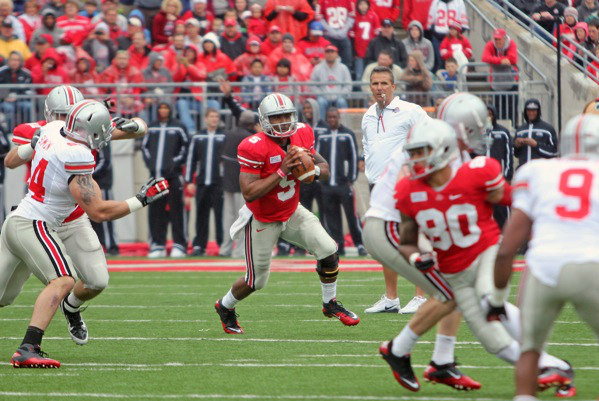Here it is:
20. TexasLol wut?!? I mean ...
19. Clemson
18. South Carolina
17. TCU
16. Arkansas
15. West Virginia
14. Georgia
13. Wisconsin
12. Florida State
11. Boise State
10. Stanford
9. Ohio State
8. Virginia Tech
7. Oklahoma State
6. USC
5. Florida
4. Oregon
3. Oklahoma
2. LSU
1. Alabama
... yeah.
My laughing-pear reaction has nothing to do with being a Michigan fanboi and everything to do with the fact that Ohio State is the only team in the country that literally can not win it all this year. That inconvenient postseason-ban thing means they (a) can't win the Big Ten since there's a championship game now, (b) can't play in the BCS title game and (c) aren't eligible for the AP poll and therefore, by rule, can't finish No. 1 in any of the currently recognized ranking systems. They can not win it all this year. Can not. I don't know how to make this any clearer. Eastern Michigan should be higher on the list. Etc.
ESPN's lame explanation is that the rankings actually aren't projections for this year and are determined via some kind of weighted formula based on offensive and defensive drive efficiency from the last five seasons. The specifics:
The Program FEI (PFEI) ratings published on this site represent a rolling five year period of drive efficiency data, weighted for more recent seasons. PFEI has a strong correlation with next-year FEI ratings (.752) and is used as the baseline data for my annual FEI projections. For years in which drive data is unavailable, I have developed an Approximated Program FEI (APFEI) rating based on final scores instead of possessions.I like the FEI drive-efficiency metric. It is very valuable in determining a team's relative quality during/after the season. It also tells me very little (in a specific sense) about future games; the writer cites a .752 correlation between program FEI and next-year FEI, which is nice but not close to being perfect (and correlation does not equal causation). It's a general guideline that basically demonstrates, in numerical form, that a team that has been cumulatively very good over the last five years is likely to be very good again the following year. Woo.
There's also this:
The national champion(s) in 23 of the last 27 seasons was ranked among the PFEI/APFEI top-20 at the start of the season.That means there were four national champions that did not start in the top 20, which in turn means that the implication that the top 20 teams are the only 20 that can win the national title is stupid ... especially when one of those 20 teams literally can not win the title. What this should be called is, like, "20 teams that have the best five-year-average drive-efficiency numbers" or something; nobody would read it, but at least it'd be accurate.
Summary: I have a beef with an ESPN copy editor (assuming copy editors still exist, which is a questionable assumption). This is very important and totally worth the 600-ish words I just wrote only because I really wanted to point out that Ohio State can not possibly, under any circumstances, win it all. OHIO!



0 comments:
Post a Comment